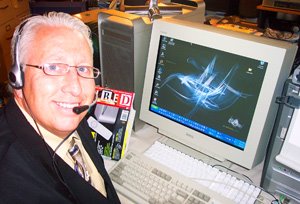Need A Lift?
++ Tom Nugent / The LiftPort Group
Space Tech :: Take a ride 62,000-miles high in an elevator car the size of a Boeing 747!
The theory behind the Space Elevator is simple. First proposed 111 years ago by a Russian scientist, it was popularized by Arthur C. Clarke in his award-winning 1978 novel, The Fountains of Paradise, and goes like this: Earth is constantly spinning. So if you attach a counterweight to it with a cable, and put it far enough away (62,000 miles), the cable will be held taut by the force of the planet's rotation (just as if you spun around while holding a ball on a string). And if you've got a taut cable, you've got the makings of an Space Elevator!

A working Space Elevator would reduce the cost of launching anything into space by roughly 98 percent. The $500 million it takes to launch the average satellite (insurance not included) would be a thing of the past. Business won't have seen anything like it since the railroad. "All of a sudden," says Brad Edwards, a former Los Alamos National Laboratory astrophysicist who founded Sedco, one of the startups, "space will be open for real activity."
 The cable, known to Space Elevator scientists as a ribbon (black line next to the red laser beam in the illustration, above), would be dropped in stages from space and hooked up to a floating platform similar to an offshore oil rig. The ribbon would most likely be made of spun carbon-nanotube fibers.
The cable, known to Space Elevator scientists as a ribbon (black line next to the red laser beam in the illustration, above), would be dropped in stages from space and hooked up to a floating platform similar to an offshore oil rig. The ribbon would most likely be made of spun carbon-nanotube fibers.An elevator car roughly the size of a Boeing 747, able to carry hundreds of people or 200 tons of cargo, could climb and descend the ribbon at a speed of 120 mph. That means the first trip to geosynchronous orbit (22,000 miles) would take seven days, but scientists say that could be reduced to four days by the time the first passengers make the journey. (Still, bring a good book for when the view of Earth gets dull.)
 Over time, a substantial transfer (way) station would be built at geostationary orbit, 36,000 kilometers (22,000 miles) up the cable. In addition to deploying satellites into other orbits, handling cargo, and even assembling or refueling spacecraft, the station could also become a tourist destination!
Over time, a substantial transfer (way) station would be built at geostationary orbit, 36,000 kilometers (22,000 miles) up the cable. In addition to deploying satellites into other orbits, handling cargo, and even assembling or refueling spacecraft, the station could also become a tourist destination!Note from Technophile: Not only would an elevator slash launch costs, but it would increase the amount of cargo capacity for orbital trips. More than 90 percent of the space shuttle's weight is fuel, with cargo making up less than 5 percent. On the elevator, no fuel is necessary, because the car would be electric, with power cells energized by a ground-based laser beam.:: Source: [LiftPort Group]
:: Innovation: Giant elevator cars replace many rocket-powered flights into space!
:: Available: 2018
:: Image Credits: Alan Chan




















1 Comments:
Excellent post, nice summary of the space elevator idea. And you credit Liftport which I find gratifying on a personel level.
Thanks and keep in touch.
Post a Comment
<< Home